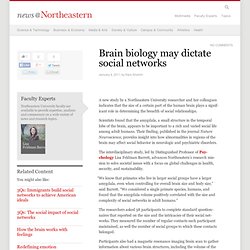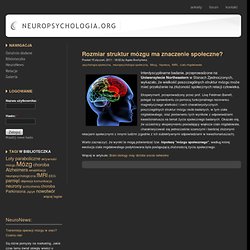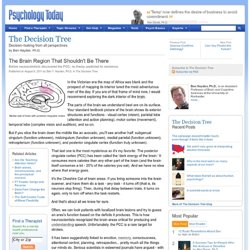

Single Worm Neurons Remotely Controlled with Lasers. Scientists have come a step closer to gaining complete control over a mind, even if that mind belongs to a creature the size of a grain of sand.

Neurony zdalnie sterowane. Brain biology may dictate social networks. A new study by a Northeastern University researcher and her colleagues indicates that the size of a certain part of the human brain plays a significant role in determining the breadth of social relationships.

Scientists found that the amygdala, a small structure in the temporal lobe of the brain, appears to be important to a rich and varied social life among adult humans. Their finding, published in the journal Nature Neuroscience, provides insight into how abnormalities in regions of the brain may affect social behavior in neurologic and psychiatric disorders. The interdisciplinary study, led by Distinguished Professor of Psychology Lisa Feldman Barrett, advances Northeastern’s research mission to solve societal issues with a focus on global challenges in health, security, and sustainability.
Rozmiar struktur mózgu ma znaczenie społeczne? Interdyscyplinarne badanie, przeprowadzone na Uniwersytecie Northeastern w Stanach Zjednoczonych, wykazało, że wielkość poszczególnych struktur mózgu może mieć przełożenie na złożoność społecznych relacji człowieka.

Eksperyment, przeprowadzony przez prof. Lisę Feldman Barrett, polegał na sprawdzeniu za pomocą funkcjonalnego rezonansu magnetycznego wielkości i cech charakterystycznych poszczególnych struktur mózgu osób badanych, w tym ciała migdałowatego, oraz porównaniu tych wyników z odpowiedziami kwestionariusza na temat życia społecznego badanych. Holograms reveal brain's inner workings: Microscopy technique used to observe activity of neurons like never before. Like far away galaxies, powerful tools are required to bring the minute inner workings of neurons into focus.

Borrowing a technique from materials science, a team of neurobiologists, psychiatrists, and advanced imaging specialists from Switzerland's EPLF and CHUV report in The Journal of Neuroscience how Digital Holographic Microscopy (DHM) can now be used to observe neuronal activity in real-time and in three dimensions -- with up to 50 times greater resolution than ever before. The application has immense potential for testing out new drugs to fight neurodegenerative diseases such as Alzheimer's and Parkinson's. Neurons come in various shapes and are transparent. To observe them in a Petri dish, scientists use florescent dyes that change the chemical composition and can skew results. Additionally, this technique is time consuming, often damages the cells, and only allows researchers to examine a few neurons at a time.
Your Gut, Your Brain, and Economics. When we think of sensory experiences, we think of sights, sounds and smells; touching and tasting.

Seldom do we think of the vast amount of sensory information encoding that occurs somewhat removed from our five senses: inside of our gut. I was surprised when I first learned about how important a role the gut plays for our direct interactions with the environment. Since researching this a little more I've become absolutely fascinated by the exciting research questions that surround the topic. These questions are of interest, not only to Neurogastroenterologists who study digestive systems (and whom I imagine must be generally skilled at spelling ridiculously long words), but also to Cognitive Scientists trying to understand the brain, Psychologists studying depression, and even Economists -like myself- researching human decision making. Consider first the basic dimension of surface area available for interacting with environmental substances.
Communication by nerve cells shown to be more diverse than believed. Aug 23, Neuroscience The data in Hua et al. support a model for the recycling of synaptic vesicles proposed by the Edwards lab several years ago.

Part 1 - "This is Your Brain on Morality" 9.14 Brain Structure and Its Origins, Spring 2009. The Brain Drain Game: Why Everybody Loses. What's The Big Idea?

The issue of immigration sits on the fault lines of culture, politics, and economics, pushed to and fro by conflicting and often irreconcilable forces. At worst, national immigration policies lurch forward like Frankenstein’s monster, stitched together from random bits of idealism, compromise, belligerence, and denial. Even those that do a good job of serving national priorities today can miss the long-term economic picture entirely. The Global Economic Picture: There’s a Brain Drain Race going on between the world’s economic leaders––a scramble to snap up the "best and the brightest” immigrants from poor and emerging nations.
Some countries, like the UK, are busy implementing policies that better position them to win this race than others. What's the Significance? For poorer countries, the consequences can be devastating: brain drain can permanently undermine their hopes for political stability and economic growth. The brain region that shouldn't be there. Medial wall of brain with posterior cingulate cortex In the Victorian era the map of Africa was blank and the prospect of mapping its interior lured the most adventurous men of the day.

If you are of that frame of mind now, I would recommend exploring the dark interior of the brain . The parts of the brain we understand best are on its surface. Your standard textbook picture of the brain shows its exterior structures and functions - visual cortex (vision), parietal lobe (attention and action planning), motor cortex (movement), temporal lobe (complex vision and audition), and so on. But if you slice the brain down the middle like an avocado, you'll see another half: subgenual cingulum (function unknown), midcingulum (function unknown), medial parietal (function unknown), retrosplenium (function unknown), and posterior cingulate cortex (function truly unknown).